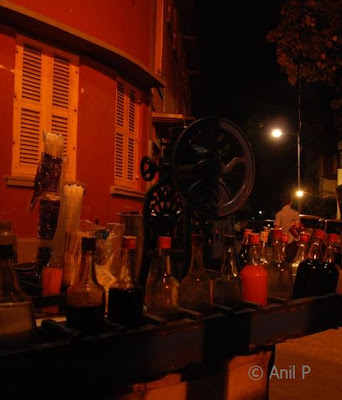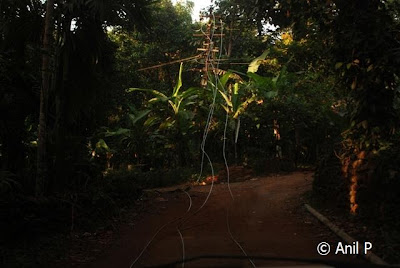Last November, before the cold set in, I exited the
Chandni Chowk metro and made my way through crowded streets on foot, taking in
the bustle on the road and beyond, juggling between dodging pedestrians and
peeking into roadside establishments, only pausing upon spotting a massive Sikh
outside the Sis Ganj Sahib Gurdwara, guarding the entrance, his muscular hand effortlessly
cradling an equally intimidating spear.
The Sis Ganj Gurdwara (a gurdwara is a place of
worship for Sikhs) stood on the Chandni Chowk street; its gold-gilded domes surmounting
the sandstone structure shone in the sun.
I hadn’t seen a Sikh this big
before and it was probably no coincidence that the community that prides itself
in its martial origins choose him to straddle the entrance, more so in the
context of the origin of the Sis Ganj Sahib Gurdwara itself.
It was here, in 1675, that Guru
Tegh Bahadur, the ninth Sikh Guru, was beheaded on the orders of the Mughal
Emperor, Aurangzeb, for refusing to convert to Islam. The Sis Ganj Sahib Gurdwara
was built on the site of his execution by Aurangzeb to honour his memory and
sacrifice.
Islam spread in India largely on
the strength of the sword brought to bear on the native population by a
succession of Muslim invaders, and not everyone had the courage to resist
conversion to Islam like Guru Tegh Bahadur did, and many who did resist and
paid with their lives are long forgotten.
~
On either side of the Chandni
Chowk road, shops abound. Schools, restaurants, clothing stores, hotels, jewellery
shops and roadside vendors among others crowd the road that connects Town Hall
and Ballimaran to the West with Red Fort to the east.
Labourers loaded a Haath Gadi
(hand-pulled wooden cart on two wheels) with large bobbins with flanges, the contents
of which were hidden behind packaging. Haath Gadi is a cheap alternative to
motorized transport over short distances and among the surest signs you’re in
old trading hubs.
Pedal and battery-powered rickshaws
together with rows of beaten blue wagons of the Central Baptist Church Primary
School, each fabricated to fit onto the back of cycle rickshaws, further added
to the familiar bustle of Chandni Chowk, the one place where you can be assured
of much of the character India was, and hopefully still is, famous for –
vibrancy of the street, or chaos as some will characterize it.
A man sat reading a newspaper in
one of the blue wagons. Each cycle rickshaw was numbered and labelled with ‘Central Baptist
Church Primary
School’.
I imagined school children making
a beeline for these school transports the moment the final bell rang, no doubt
scrambling for their favourite seats in the beat-up wagons.
K tells me these cycle-rickshaws improvised with covered carriages for use in ferrying children to school and back were a fairly common sight in much of Delhi until early-1990s, eventually making way for school buses, partly after parents (and in some instances, schools) became safety conscious. Moreover, school buses made for quicker and comfortable journeys. As opposed to the rickshaw-wagon that accommodated between 6-7 school children, a school bus accommodated upwards of 30 children.
Moreover there was an element of status consciousness among certain sections of Delhi society once affluence began to trickle into upmarket social circles. The
school ka rickshaw trundling to the door step would no longer do.
While the blue carrier rickshaws in Chandni Chowk above appear to belong to or are authorised by the Central Baptist Church Primary School, it wasn't so with most schools back then. Each rickshaw was owned and operated by the rickshaw drivers, ensuring a steady income through the academic year.
To this day these tri-cycle
school ka rickshaws can still be seen in some parts of Delhi.

I had just stepped out of the
Digambar Jain Mandir (Lal Mandir) at the intersection of Chandni Chowk Road with Netaji Subhash
Marg when I stumbled into furious solicitation of passengers by burly drivers
at the steering of battery-powered rickshaws that I had only heard about in the
year before.
Variously called e-Tricycles, the
three-wheelers were a much trumpeted addition to Delhi roads on the eve of the Commonwealth
Games, a visible effort at going eco-friendly, something one of these rickshaws
displayed proudly on the canopy above the driver.
It read: "Eco-Friendly. Battery Operated". And if the words were insufficient to push
home the message, the green background ensured they did.
I’ll leave the debate on ‘Are
batteries eco-friendly?’ for another time if for nothing else than for the fact
that atleast the Govt. is thinking in the right direction.
Men and women, some lugging
purchases made in the bazaars of Chandni Chowk crowded the few battery-powered
rickshaws outside the Jain temple. The Red Fort stood to my right, its ramparts marking the skyline.
I had gone looking for the Bird Hospital
in the temple complex where rude caretakers keep an eagle-eye on visitors for
signs they’re about to step an inch beyond the imaginary (and invisible lines)
they’ve drawn to mark the limit beyond which they cannot wear their footwear.
~
The battery-powered rickshaws,
limited to speeds below 25 kmph and powered by a motor less than 250 kW, were originally
meant to connect commuters from pick-up points with Metro stations. A rate was
fixed for the distance between boarding points and the Metro Station.
The Chandni Chowk Metro Station was
located a 10-12 minute walk away from where I stood outside the Jain temple, discounting
the time it takes to get through the crowds. If you’re one for looking into
shops along the way, and I see no reason why one wouldn’t be curious of what
lay beyond the shop fronts given their eclectic wares, I’d subtract a few more
minutes from the walk.
Even so, a ride in one of the
eco-friendly rickshaw saves hassled pedestrians time and energy, more so if
they’re lugging their purchases.
The rickshaw drivers call out to
commuters the moment they draw up at the boarding point. The quicker they reach
capacity, the more rounds they can notch up between the Metro station and
boarding-points, translating to more earnings for the day.
The rickshaws I saw had seating
space for four, two facing two, though I saw a fifth squeezing in on more than
one occasion, and a sixth who shared seating with the rickshaw driver upfront.
A family of five fresh from
shopping in Chandi Chowk haggled with the rickshaw driver of one of these
eco-friendly rickshaws to accommodate them at the expense of a solitary
commuter already seated in the rickshaw.
They presented him with no-brainer
– “All five of us or none”.
Not one to let his conscience get
in between business choices, he requested the seated passenger to get off to
make way for the “five”, telling him, “There’s another rickshaw behind mine.
Get into it.”
He was not about to turn the five
down for one ‘liability’.
The visibly displeased man,
hounded by the sight of the family of five glaring at him with a sense of
righteousness unique to collective bargaining, muttered curses under his breath
before getting off. I could only hope he didn’t have to contend with another
family of five at the next rickshaw he sought.
The family got on, and the
rickshaw sauntered past me.
~
Also known as Electric Tricycle,
the sale of these “pollution-free” battery-operated three-wheelers are
advertised as a means to earn 20-25 K monthly.
As they’re limited to under 25
kmph and powered by a motor less than 250 kW, they do not come under the
purview of the Motor Vehicles Act and do not require vehicle registration or a
driver’s license to operate them.
~
Eco-friendly rickshaws are fine.
But what Delhi really needs is commuter-friendly rickshaw drivers who do not pick and choose the routes they want to ply, especially the 'notorious' green and yellow rickshaws.
Further Reading


























